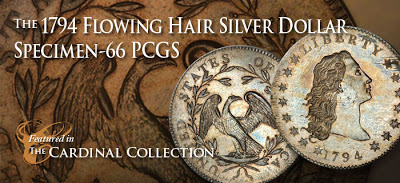
Although copper cents were first struck and issued in March 1793, it was not until 1794 that the first silver coins were made at the Philadelphia Mint. The reason was political, so to speak. A bond of $10,000 had to be posted by the coiner before precious metals could be used. This is probably equivalent to posting a million dollar bond today! Finally, a surety was found, and silver production got under way. The first mintage was of the half dollar denomination. Dies dated 1794 were made for the half dime, the smallest silver denomination, but were not used that year. Accordingly, 1794 half dimes were actually struck in 1795.
Later in the year a press of sufficient capacity was on hand, and production of the dollar, the largest silver coin of the realm, commenced. Problems ensued, and a number of pieces were discarded as unsatisfactory. Complete details can be found in my two-volume 1993 study Silver Dollars and Trade Dollars of the United States: A Complete Encyclopedia. Stack’s Bowers Galleries is in the process of updating the information on silver dollars of the 1794-1804 years and publishing them in a separate edition with announcements to be made soon. This will contain important contributions by R.W. Julian and Martin Logies.
When coinage was completed, 1,758 silver dollars were found to be satisfactory enough to be released into circulation. The same pair of dies was used for all. The faces were not aligned completely parallel in the coining press, with the result that all known examples are slightly weak at the lower left and on the corresponding part of the reverse. In 1993 when I did my study on silver dollars, I used information from Jack Collins, now deceased, who thought that approximately 125 to 135 different examples survived. In recent times Martin Logies, a careful scholar, has identified 134 different, eliminating duplication. Allowing for some that he has not studied and others that may still be hidden away, it is probably safe to estimate the number known as about 150. Of these, the forthcoming Cardinal Collection example, with the Carter pedigree, is far and away the finest in existence, as noted. Runners up in the Mint State category, but a number of points away, are the two bright Uncirculated pieces that were sold by Christie’s in London in 1964, under the title of the Lord St. Oswald Collection. As Michael Hodder has revealed, study shows that they did not belong to Lord St. Oswald at all, but to an early British traveler who went to the United States in 1795 and brought back with him a marvelous group of current coins of that date and also 1794. Back then there was a strong numismatic interest in Great Britain, although in the United States hardly anyone collected coins. As to other examples in Mint State beyond those previously mentioned, probably no more high grade AU or lower level Mint State pieces exist than can be counted on the fingers of one hand. I expect that all eyes will be on the Stack’s Bowers Galleries sale in January when this coin is sold without reserve and will no doubt make auction history!





